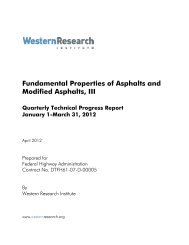Fundamental Properties of Asphalts and Modified Asphalts, III
Fundamental Properties of Asphalts and Modified Asphalts, III
Fundamental Properties of Asphalts and Modified Asphalts, III
Create successful ePaper yourself
Turn your PDF publications into a flip-book with our unique Google optimized e-Paper software.
comprised <strong>of</strong> tens <strong>of</strong> thous<strong>and</strong>s <strong>of</strong> different types <strong>of</strong> molecules that otherwise would need to be<br />
characterized if a totally fundamental approach to the problem were to be considered.<br />
It has also been observed in previous experiments [Robertson et al. 2005, 2006] that different<br />
asphalts tend to form self-ordered microstructural “features” to different degrees with different<br />
crude sources. This was demonstrated at the asphalt-air free surface interface when prepared as<br />
solvent spin-cast, thin-film coatings with thicknesses ranging from 3 microns to as thin as 150<br />
nm. Generally speaking, structures with clearer phase boundaries are observed as the thickness<br />
<strong>of</strong> these “ultra-thin” films is decreased below 2 microns [Robertson et al. 2005]. Thicker films<br />
tend to exhibit larger structures, particularly the bumble bee shaped structures that appear to<br />
“grow” to a limiting size in 10’s <strong>of</strong> microns thick films with less distinguishable interface<br />
boundaries. Inevitably, the formation <strong>of</strong> these microstructures in very thin films <strong>of</strong> asphalt leads<br />
directly to the development <strong>of</strong> interfacial grain boundaries between chemically different phases<br />
<strong>of</strong> materials. These interfacial grain boundaries then constitute discontinuities in the film that<br />
could lead to fracture initiation in actual pavement structures whether they were to rapidly<br />
develop under normal paving conditions or gradually development over time.<br />
The current experimental approaches should not be considered a direct representation or<br />
simulation <strong>of</strong> pavement structures. Contrarily, in the present research, asphalts are prepared as<br />
thin-films that are similar in magnitude to the average thicknesses <strong>of</strong> asphalt films estimated for<br />
pavements (e.g., 5-15 microns or 8 to 10-microns on average [K<strong>and</strong>hal <strong>and</strong> Chakaraborty 1996;<br />
K<strong>and</strong>hal et al. 1998]). In most cases they are prepared as ultra-thin-films, representing<br />
“theoretical” slices <strong>of</strong> asphalt very close to <strong>and</strong> in contact with an aggregate interface. These<br />
systems are then investigated in order to determine the kinetics <strong>of</strong> microstructure formation as a<br />
function <strong>of</strong> film-thickness, temperature fluctuation, <strong>and</strong> method <strong>of</strong> film preparation (e.g., solvent<br />
spin-coating techniques). This approach has also been adopted due to the difficulty <strong>of</strong><br />
experimentally observing asphalt-aggregate interfacial interactions. As a result, thin-film<br />
experimentation on ideal systems combined with computation simulations will be needed to<br />
adequately study these types <strong>of</strong> systems in order to make recommendations as to how to prolong<br />
the lifecycle <strong>of</strong> pavements due to fatigue.<br />
Much <strong>of</strong> the motivation behind the work that has been proposed in this subtask stems from the<br />
desire to know why <strong>and</strong> how the microstructures that have been observed in these materials, as<br />
observed by atomic force microscopy [Loeber et al. 1996; Pauli <strong>and</strong> Grimes 2003], could<br />
contribute to pavement performance. Consequently, it is hypothesized that the thermo-kinetic<br />
processes <strong>of</strong> phase transformations (i.e., molecular order-disorder kinetics) are anticipated to<br />
directly influence the rheological properties <strong>of</strong> these materials at the mastic thin-film interfaces<br />
in actual pavement structures. These processes include; wax melting-crystallization, potential<br />
for flocculation <strong>of</strong> asphaltenes, chromatographic interactions <strong>of</strong> polar <strong>and</strong> aromatic molecules<br />
with mineral aggregates/filler surfaces, <strong>and</strong> others that are influenced by fluctuations in<br />
temperature <strong>and</strong> shear rate. An improved underst<strong>and</strong>ing <strong>of</strong> the correlations between these phase<br />
transformations <strong>and</strong> rheological properties will help explain the nature <strong>of</strong> fatigue damage <strong>and</strong><br />
subsequent self-healing phenomena brought on during rest periods. In other words, how does the<br />
asphalt chemical composition lead to the order-disorder transitions that produce micro<br />
structuring at interfacial boundaries <strong>and</strong> thin-film regions? Also, how does this ultimately lead<br />
47





